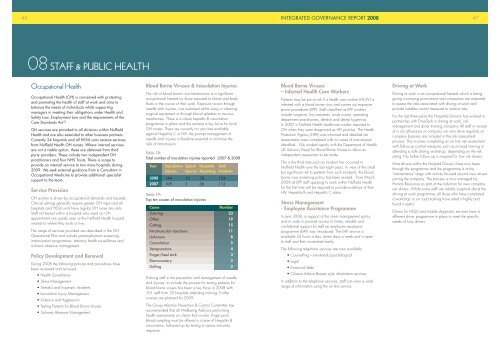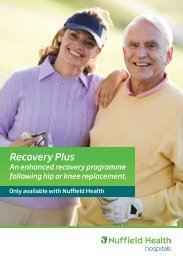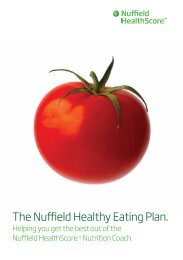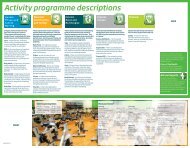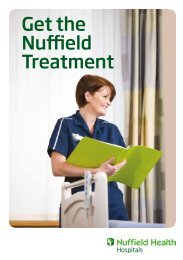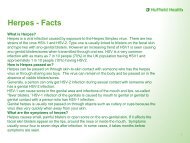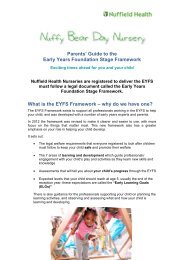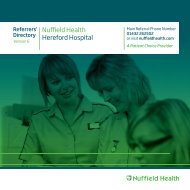Integrated Governance Report 2008 - Nuffield Health
Integrated Governance Report 2008 - Nuffield Health
Integrated Governance Report 2008 - Nuffield Health
Create successful ePaper yourself
Turn your PDF publications into a flip-book with our unique Google optimized e-Paper software.
46 INTEGRATED GOVERNANCE REPORT <strong>2008</strong><br />
47<br />
08<br />
STAFF & PUBLIC HEALTH<br />
Occupational <strong>Health</strong><br />
Occupational <strong>Health</strong> (OH) is concerned with protecting<br />
and promoting the health of staff at work and aims to<br />
balance the needs of individuals whilst supporting<br />
managers in meeting their obligations under <strong>Health</strong> and<br />
Safety Law, Employment Law and the requirements of the<br />
Care Standards Act 23<br />
OH services are provided to all divisions within <strong>Nuffield</strong><br />
<strong>Health</strong> and are also extended to other business partners.<br />
Currently 24 hospitals and all HSSU units receive services<br />
from <strong>Nuffield</strong> <strong>Health</strong> OH nurses. Where internal services<br />
are not a viable option, these are obtained from third<br />
party providers. These include two independent OH<br />
practitioners and four NHS Trusts. There is scope to<br />
provide an internal service to two more hospitals during<br />
2009. We seek external guidance from a Consultant in<br />
Occupational Medicine to provide additional specialist<br />
support to the team.<br />
Service Provision<br />
OH activity is driven by occupational demands and hazards.<br />
Clinical settings generally require greater OH input and all<br />
hospitals and HSSU units have regular OH nurse site visits.<br />
Staff not based within a hospital who need an OH<br />
appointment are usually seen at the <strong>Nuffield</strong> <strong>Health</strong> hospital<br />
nearest to where they work or live.<br />
The range of services provided are described in the OH<br />
Operational Plan and include pre-employment screening,<br />
immunisation programmes, statutory health surveillance and<br />
sickness absence management.<br />
Blood Borne Viruses & Inoculation Injuries<br />
The risk of blood borne virus transmission is a significant<br />
occupational hazard for those exposed to blood and body<br />
fluids in the course of their work. Exposure occurs through<br />
needle stick injuries, cuts sustained whilst using or cleaning<br />
surgical equipment or through blood splashes to mucous<br />
membranes. There is a robust hepatitis B vaccination<br />
programme in place and this remains a key focus for local<br />
OH nurses. There are currently no vaccines available<br />
against Hepatitis C or HIV: the prompt management of<br />
needle stick injuries is therefore essential to minimise the<br />
risks of transmission.<br />
Table 18:<br />
Total number of inoculation injuries reported - 2007 & <strong>2008</strong><br />
Year Inoculation Splash Hospitals Total<br />
Injuries Injuries <strong>Report</strong>ing Incidents<br />
<strong>2008</strong> 144 10 30 154<br />
2007 109 3 36 112<br />
Table 19:<br />
Top ten causes of inoculation injuries<br />
Cause<br />
Number<br />
Suturing 23<br />
Other 19<br />
Cutting 15<br />
Intramuscular injections 11<br />
Unknown 8<br />
Cannulation 5<br />
Venepuncture 4<br />
Finger/heel stick 3<br />
Elecrocautery 2<br />
Drilling 2<br />
Blood Borne Viruses<br />
– Infected <strong>Health</strong> Care Workers<br />
Patients may be put at risk if a health care worker (HCW) is<br />
infected with a blood borne virus and carries out exposure<br />
prone procedures (EPP). Staff classified as EPP workers<br />
include surgeons, first assistants, scrub nurses, operating<br />
department practitioners, dentists and dental hygienists.<br />
In 2007 a <strong>Nuffield</strong> <strong>Health</strong> healthcare worker reported to<br />
OH when they were diagnosed as HIV positive. The <strong>Health</strong><br />
Protection Agency (HPA) was informed and detailed risk<br />
assessments were completed with no cases of transmission<br />
identified. We worked openly with the Department of <strong>Health</strong><br />
UK Advisory Panel for Blood Borne Viruses to allow an<br />
independent assessment to be made.<br />
This is the third time such an incident has occurred in<br />
<strong>Nuffield</strong> <strong>Health</strong> over the last eight years. In view of the small<br />
but significant risk to patients from such incidents, the blood<br />
borne virus screening policy has been revised. From March<br />
2009 all EPP staff applying to work within <strong>Nuffield</strong> <strong>Health</strong><br />
for the first time will be required to provide evidence of their<br />
HIV, Hepatitis B and Hepatitis C status.<br />
Stress Management<br />
- Employee Assistance Programme<br />
In June <strong>2008</strong>, in support of the stress management policy<br />
and in order to provide access to timely, reliable and<br />
confidential support for staff an employee assistance<br />
programme (EAP) was introduced. The EAP service is<br />
available 24 hours a day, seven days a week and is open<br />
to staff and their immediate family.<br />
The following telephone services are now available:<br />
• Counselling – emotional/psychological<br />
• Legal<br />
• Financial/debt<br />
• Citizens Advice Bureau style information services<br />
Driving at Work<br />
Driving at work is an occupational hazard which is being<br />
giving increasing prominence and companies are expected<br />
to assess the risks associated with driving at work and<br />
provide suitable control measures to reduce risks.<br />
For the last three years the Hospitals Division has worked in<br />
partnership with DriveTech a driving at work, risk<br />
management and driver training company. All staff in receipt<br />
of a car allowance or company car who drive regularly on<br />
company business are included in the risk assessment<br />
process. This involves completing an on line risk assessment<br />
with follow up control measures such as on-road training or<br />
attending a safe driving workshop, depending on the risk<br />
rating. No further follow up is required for low risk drivers.<br />
Most drivers within the Hospital Division have now been<br />
through the programme and the programme is at the<br />
‘maintenance’ stage with activity focused around new drivers<br />
joining the company. The process is now managed by<br />
Human Resources as part of the induction for new company<br />
car drivers. Whilst some staff are initially sceptical about the<br />
driving at work programme, all those who have completed<br />
a workshop or on road training have rated it highly and<br />
found it useful.<br />
Drivers for HSSU and mobile diagnostic services have a<br />
different driver programme in place to meet the specific<br />
needs of lorry drivers.<br />
Policy Development and Renewal<br />
During <strong>2008</strong> the following policies and procedures have<br />
been reviewed and re-issued:<br />
• <strong>Health</strong> Surveillance<br />
• Stress Management<br />
• Stressful and Traumatic Incidents<br />
• Inoculation Injury Management<br />
• Violence and Aggression<br />
• Testing Patients for Blood Borne Viruses<br />
• Sickness Absence Management<br />
Training staff in the prevention and management of needle<br />
stick injuries, to include the process for testing patients for<br />
blood borne viruses has been a key focus in <strong>2008</strong> with<br />
101 staff from 20 hospitals attending training. Further<br />
courses are planned for 2009.<br />
The Group Infection Prevention & Control Committee has<br />
recommended that all Wellbeing Advisors performing<br />
health assessments on clients that involve finger prick<br />
blood sampling must be offered a course of Hepatitis B<br />
vaccination, followed up by testing to assess immunity<br />
response.<br />
In addition to the telephone services, staff can view a wide<br />
range of information using the on line service.


